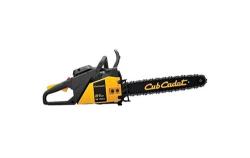 Whether you’re looking to cut some firewood so it will have time to season for next year or you need to trim some branches that could be toppled by the weight of ice and snow, it’s a good time to go over your Cub Cadet chainsaw. These tips will help you get your engine, chain and bar ready for the season.
Whether you’re looking to cut some firewood so it will have time to season for next year or you need to trim some branches that could be toppled by the weight of ice and snow, it’s a good time to go over your Cub Cadet chainsaw. These tips will help you get your engine, chain and bar ready for the season.
Safety
Using a chainsaw is dangerous without the right techniques and equipment, but this tool can also do some harm when you’re just working on it. Always wear thick gloves when handling your chainsaw, and keep the spark plug wire disconnected to prevent accidental starts.
Fuel and Oil
On modern Cub Cadet chainsaws, the engine is designed to use gasoline mixed with oil at a 50:1 ratio. That’s equivalent to 2.56 oz. of oil per gallon or 20 ml per liter. High octane fuels and high-quality two-stroke oil designed for air cooled engines are recommended for the best performance. Two stroke engines are particularly sensitive to fuel freshness, so it’s best to use gas that has been purchased within the last month, even if it has been treated with a fuel stabilizer.
Bar & Chain Lubrication
The chain can travel at speeds up to 45 MPH, which makes lubrication critical to the operation and durability of your chainsaw. Always refill the chain oil tank whenever you refill the fuel tank.
It used to be common to use clean or used motor oil on chainsaws, but your Cub Cadet’s chain lubrication system should only be used with oil made specifically for chainsaw bars. Unlike motor oil, bar and chain oil is extremely tacky, letting it cling to the chain long enough to coat the entire bar, greatly increasing its life.
Chain Tensioning
As the chain wears, it will stretch out and need to be re-tensioned using the tensioner screw, located on the front of the engine cover next to the bar. To check the tension, lift the top of the chain: there should be just a few millimeters of space between the chain and the bar.
Chain Sharpening
The debris coming out of the chainsaw cut should be in the form of small chips. If the debris is mostly sawdust, the blades are dull. If they become too dull, the chain can get stuck in the wood, causing the chainsaw to buck dangerously. For the best results, the chain should be sharpened each time the gas tank is refilled.
Chainsaw blades have two components: a guide and a one-sided cutting surface. The guides keep the chainsaw at the right height for the blades to cut evenly through the wood, while the cutting surfaces alternate between left and right-sided blades to get an even cut. Both the blade and guide need to be filed down as a pair so the blade can cut at the correct depth.
Information on the blade angle and guide height can be found in your chainsaw’s owner’s manual. To sharpen the chain correctly, you’ll need a chainsaw-specific sharpening kit. The blades themselves should be filed with a round file that is the same diameter as the blade curve, paired with an angle gauge to get the correct blade shape. A flat file and depth gauge should be used on the blade guides.
When sharpening, the chain brake needs to be engaged and the bar clamped in a vice to keep the chain steady as you work. When you’re ready to move to the next blade, disengage the brake and slide the chain to get the blade into position.
Getting Parts for Your Cub Cadet Chainsaw
Is it time to replace your chain or bar? www.cubparts.com is a certified Cub Cadet dealer, and our massive warehouse lets us keep parts in stock for everything from older commercial saws to the new CS 511 so you can get what you need quickly. We can send whatever you need for your Cub Cadet to any address in the USA and Canada.
